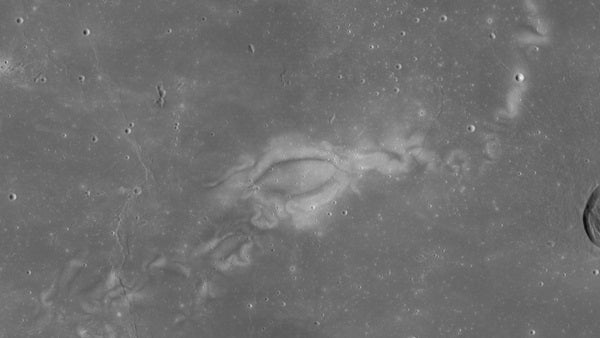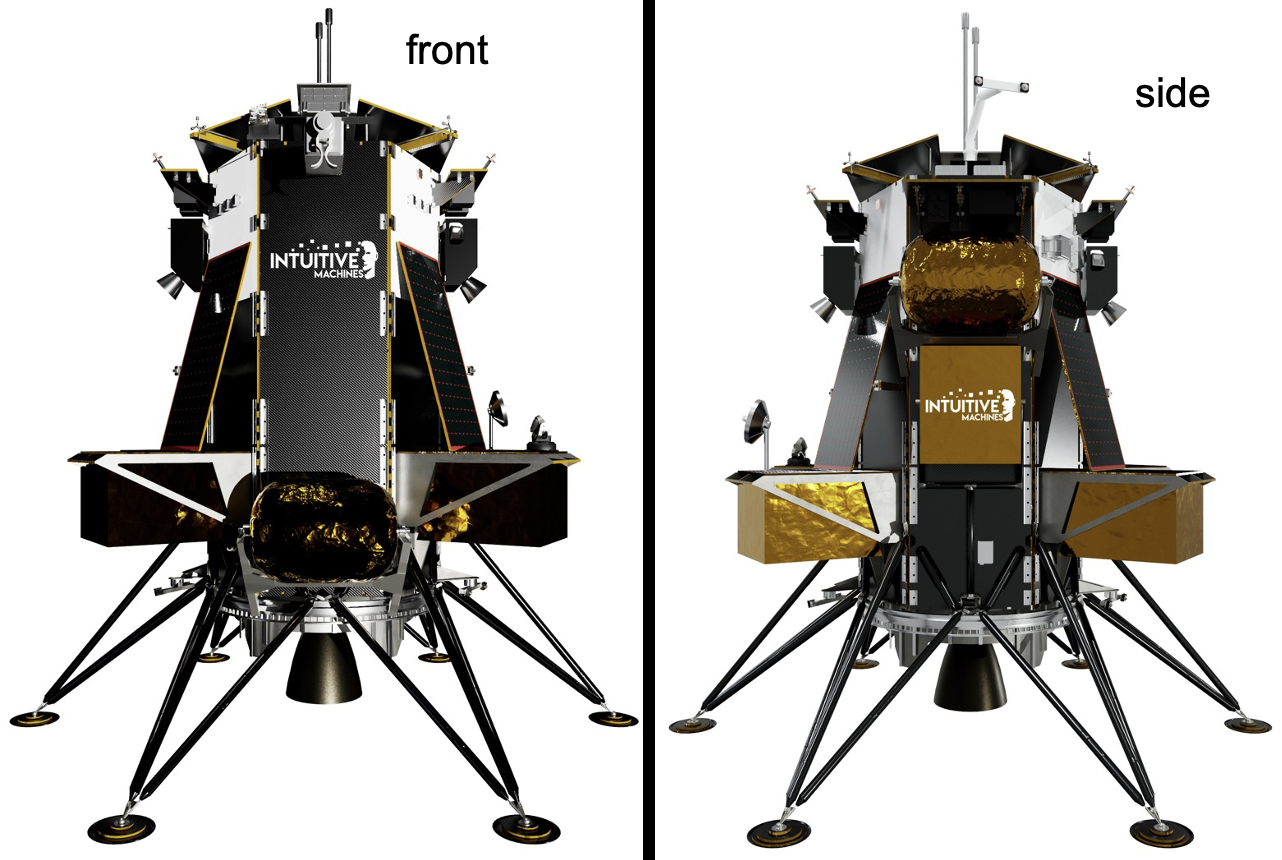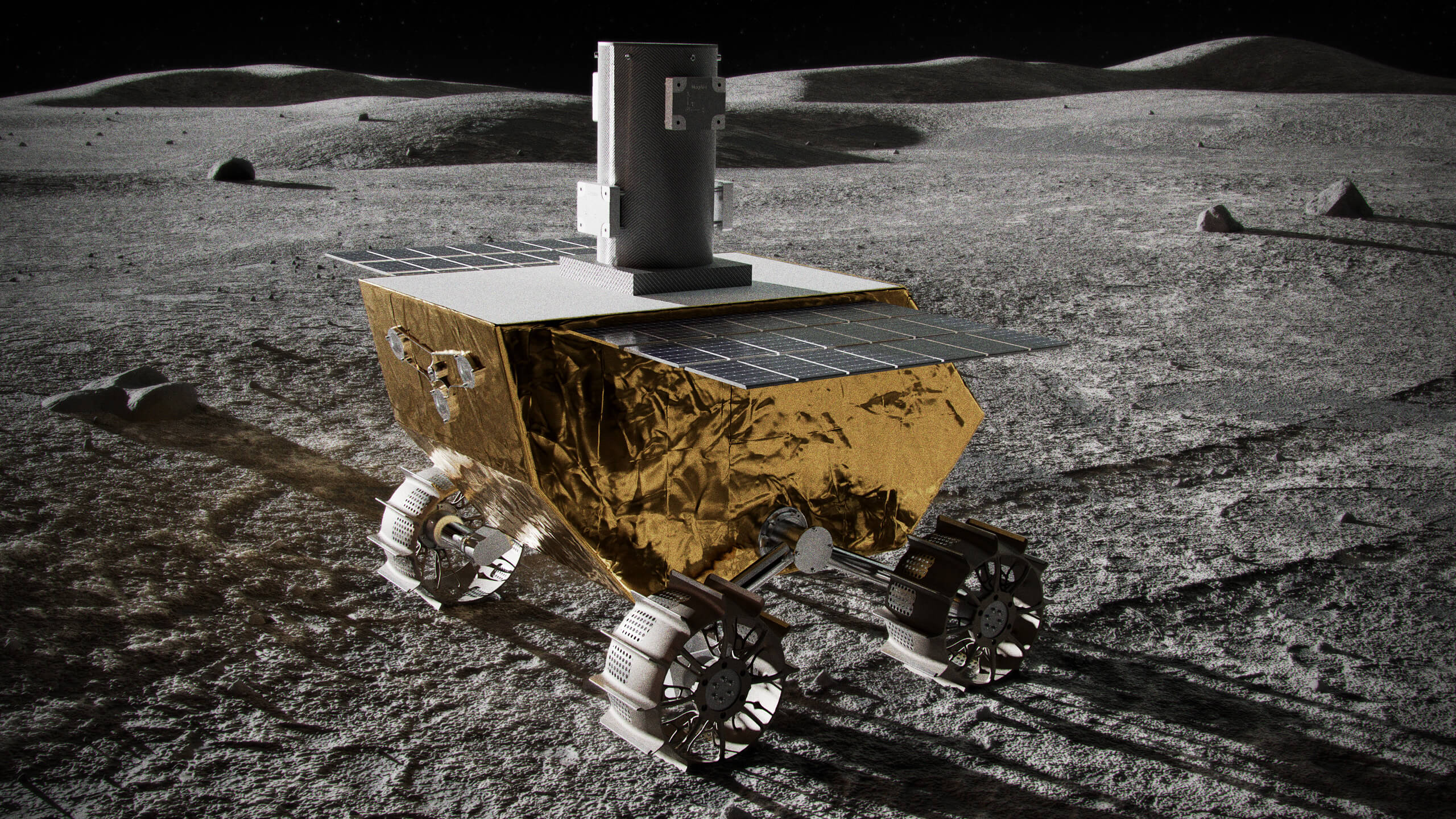
This artist’s concept shows the Lunar Vertex rover exploring Reiner Gamma on the Moon. Credit: Johns Hopkins APL/Lunar Outpost/Ben Smith
A new era in lunar research is coming, and Lunar Vertex is getting ready to lead the way.
Lunar Vertex is NASA’s first so-called PRISM mission (Payloads and Research Investigations on the Surface of the Moon). PRISM taps into the Commercial Lunar Payload Services program that uses privately built landers to deliver NASA science and other payloads to the lunar surface.
PRISM missions are meant to be lower-cost, faster-to-flight programs. There is a mass limit of just over 100 pounds (45 kilograms) — so the science instruments have to be small — and the budget for the first PRISM suite is just $30 million (excluding the lander and the launch vehicle).
Lunar Vertex is first in line, and recently has hit a number of major milestones on its way to a June 2024 launch.
David Blewett, the principal investigator for Vertex and a scientist at the Applied Physics Laboratory (APL) at Johns Hopkins University, tells Astronomy that “all instruments have been delivered … on time, on budget.” That includes the instruments to be mounted directly on the Intuitive Machines lander, which will carry the rover — built by Lunar Outpost, a small company near Denver.

Mysterious Reiner Gamma
Vertex will put a rover on the Moon at the mysterious “lunar swirl” Reiner Gamma. It is the first dedicated mission to study this mysterious region, visible through amateur telescopes as a kind of paisley-like marking on the nearside’s Oceanus Procellarum.
Lunar swirls look a bit like creamer in coffee. They are white against the gray lunar regolith, have no surface topographic definition, and are associated with stronger local magnetism. (The Moon has no global magnetic field.) How the swirls formed and their relationship to the local magnetic field remains unclear. The interaction of the solar wind with these magnetic anomalies is also a puzzle.
“The beautiful patterns of bright and dark materials in the magnetic regions could reveal the effects of magnetism on surface weathering,” said Jörg-Micha Jahn in a release from the Southwest Research Institute (SwRI), where Jahn leads the mission’s plasma spectrometer, called the Magnetic Anomaly Plasma Spectrometer (MAPS). “Nearby regions not protected by magnetic fields serve as controls. Lunar Vertex could help us quantify space weathering and the relative roles of solar wind exposure versus the effects from cosmic dust hitting the surface. Scientists could then apply this to understand the history and evolution of airless bodies across the solar system.’”
The mission will examine all that and more, including whether lunar swirls and the associated magnetic fields formed by internal or external processes, as well as the three-dimensional structure of Reiner Gamma’s local mini-magnetosphere.
The instrument suite
The lander will carry three Lunar Vertex instruments: a camera array, a magnetometer, and the plasma spectrometer.
Nine cameras built by Redwire comprise the Vertex Camera Array, which will provide a 360º view for photographic analysis of geology and for photometry, which measures difference in brightness as the solar illumination changes throughout the lunar day. These brightness changes are an important part of understanding and mapping Reiner Gamma, whose whiteish patches have a higher albedo (reflectivity) than the space-weathered, darker surrounding maria.
The Vector Magnetometer–Lander, built by APL, will measure the local magnetic field as the craft cruises, descends and touches down.
And MAPS will detect and measure ions and electrons reaching — or, at least, reaching toward — the Moon’s surface at Reiner Gamma. MAPS is an iteration of a similar instrument that flew on the European Space Agency’s Rosetta comet mission. “MAPS will gather sensitive, high-resolution insights that spacecraft orbiting around the Moon cannot achieve. It offers more than four times higher resolution than instruments typically orbiting around Earth or the Moon,” according to SwRI.

On the move
In April, Lunar Outpost delivered the rover to APL. Since then, the rover has been undergoing a variety of tests and troubleshooting, including vibration and thermal vacuum tests, as well as evaluations of its power systems to data transmission.
For the two-week mission — one solar day on the Moon — the rover will carry the Vector Magnetometer–Rover atop a mast. It will map the “the spatial variability of the magnetic field,” says Blewett.
The rover also carries a microscope. The Rover Multispectral Microscope, provided by Canadensys Aerospace, will magnify and examine lunar regolith up-close at five wavelengths. This will provide measurements of regolith composition and texture at Reiner Gamma, which will help us understand how the swirl differs from the non-swirl maria. It will also give a better sense of whether the swirl originated from, say, cometary modification or is the result of decreased space weathering under the local magnetic umbrella.
To make its way around Reiner Gamma, the Vertex rover “uses a hybrid computer-vision/LIDAR guidance, navigation, and control … system for autonomous navigation,.” according to Blewett. “The autonomy software allows a human operator to lay out waypoints for the rover to execute.”
The rover’s possible traverses are being worked out now, Blewett says. “It’s surprisingly complicated.” The team must consider power levels, battery recharge times, solar panel temperatures, and the time it takes to transfer data to the lander (and the radio is another power drain). Such considerations might have been modeled entirely before launch on a more expensive mission, but PRISM missions are designed based on scaled-back on paperwork and reporting, as well as a higher level of risk.
One thing is for certain: When the rover is deployed from the lander, it “will make a beeline into sunlight,” Blewett says. The side of the lander where the rover will be stowed will be in shade, and the morning Sun will be only about 10° above the horizon at landing. The rover’s solar panels will stay tucked by its side while the Sun is low; then, contingent on solar lighting and temperature, one or both will unfold.
The goal is a drive of least 66 feet (20 meters) to get clear of the lander’s retrorocket blast zone, then to head from the swirl’s bright region toward a dark lane in order to compare and contrast the regolith and magnetic fields between the two.
The PRISM difference
“All of this is happening really fast,” Blewett says of the mission planning. “We’re the first of the NASA PRISM suites, so there’s a lot of institutional mindset shifts that have to take place. This is conducted under requirements that don’t consider us to be a flight program. It’s a research and technology project.” In more expensive missions, he notes, “Everything is tested. Every anomaly is resolved. Everything is modeled to the nth degree. With PRISM, we don’t have to do that and we don’t have the budget to do that.”
Still, certain tests are crucial, including what Blewett calls the “day in the life test,” in which the rover was subjected to simulated flight conditions, landing, and deployment. Lunar Vertex was also subjected to another necessary test in December: a NASA acceptance review.
Assuming it’s good to go, the rover will be packed in a case (with shock sensors that turn red if it’s seriously bumped) and driven by truck to Intuitive Machines in Houston. There, the rover — about the size of a big shoebox — will be integrated onto the Nova-C lander. Once that’s done, the whole package will be shipped to Cape Canaveral, where it will be integrated with a Falcon 9 rocket.
Assuming all goes well, when the lander touches down at Reiner Gamma later this year, NASA’s first lunar PRISM will be a success.

